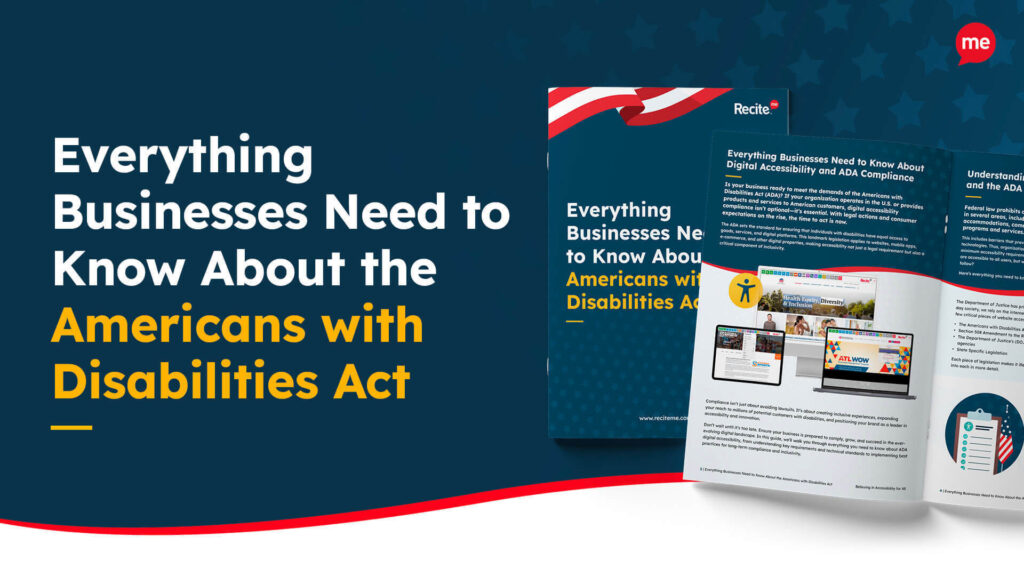Get A Free ADA Compliance Audit Of Your Website
Download NowDrupal is a free, open source Content Management System tailored towards enterprise businesses. It’s a popular choice as it offers the flexibility to create diverse websites, from small-scale to large and complex.
Developing and modifying your Drupal site is also free, with a catalogue of over 40,000 modules and 2,500 themes. But how can you ensure your Drupal website is ADA compliant? Web accessibility is crucial for all online businesses. In this post, we’ll explore the ADA requirements, potential violations, and more.
Understanding what is required for Drupal ADA compliance
Before you start tackling accessibility on your Drupal site, you’ll need a clear grasp of ADA compliance. The Americans with Disabilities Act (ADA) was created to enshrine the rights of disabled people within US law. This ensures they are protected from discrimination across many areas of public life, including federal services and commercial businesses.
You might be familiar with the requirements for physical adjustments, such as wheelchair ramps. However, website accessibility is also covered, particularly by Title II and Title III.
The Web Content Accessibility Guidelines are typically used as the framework for ADA web compliance. This refers to internationally-recognized guidelines for digital accessibility across websites and applications, and has several versions and levels.

For ADA compliance, it is recommended that you aim to meet WCAG 2.1 Level AA as a minimum.
Does Drupal offer any useful accessibility features in the platform?
Drupal takes accessibility seriously, with specialized accessibility features enabled on its core module. The Drupal Core module and themes have strict accessibility criteria. So, these will typically be more compliant than the options made by community contributors.

However, there are some exceptions, such as accessibility-focused contributed themes. You may need to search for these, as according to the Drupal website, they are not formally organized.
Beyond this, the platform also has a designated accessibility team for addressing accessibility issues on Drupal. So, as website builders go, it has lots of benefits for inclusive web development.
Want to make sure your website is compliant with the Americans with Disabilities Act? Then unlock the ADA compliance checklist now. Discover actionable steps to ensure ADA compliance, helping you avoid lawsuits and any other negative consequences of non-compliance.
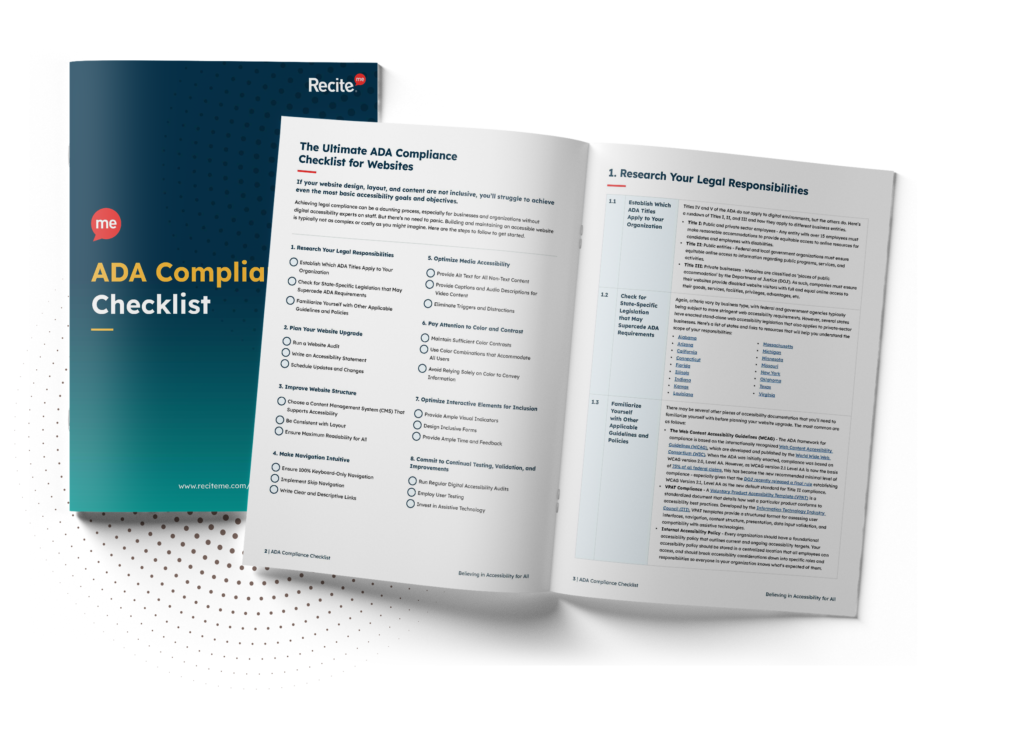
ADA Violations you might find on your Drupal site and how to fix them
If you’re not familiar with digital accessibility, you might not know where to find ADA violations on your website. Some are visual and relatively obvious, but others might catch you out.
Below, we’ve listed some common violations and how to fix them.
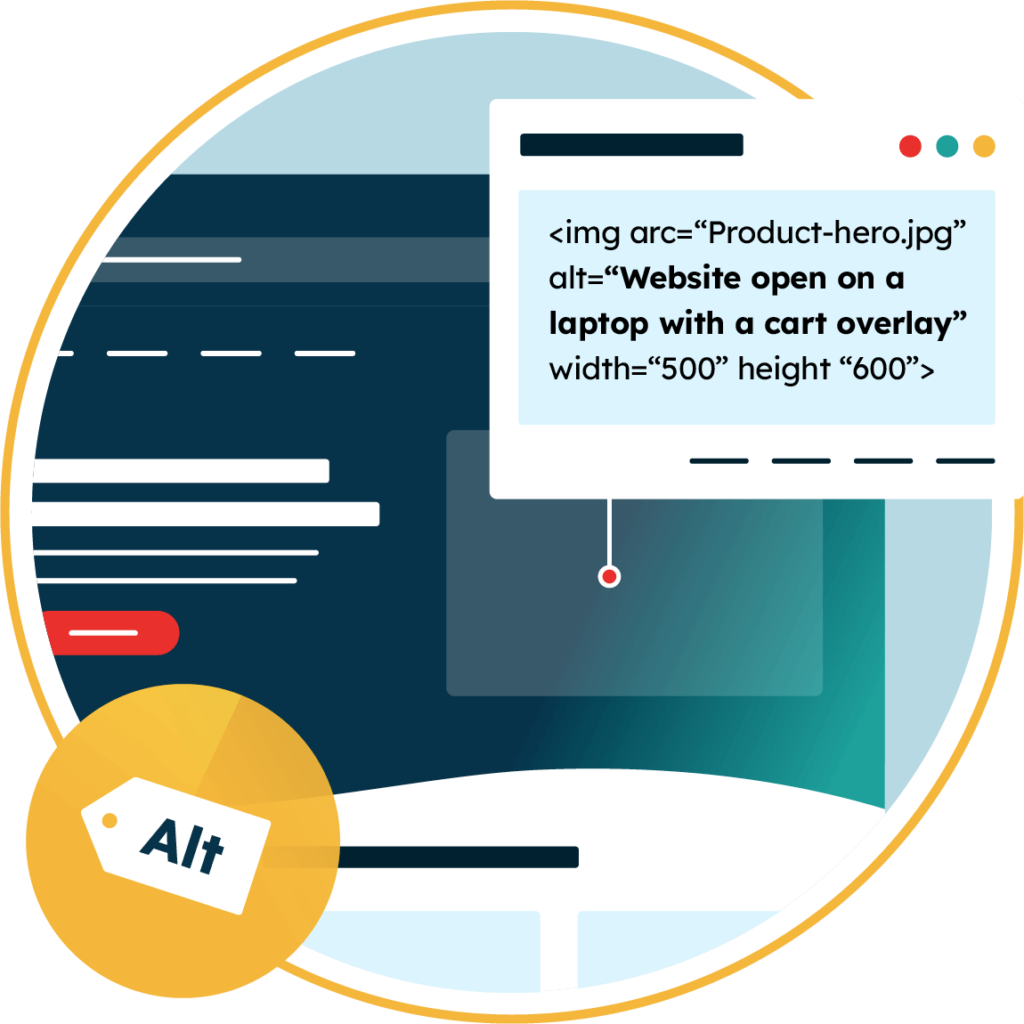
Non-descriptive or missing image alt text
Alt-text (alternative text) describes images on a website. Developers can add it via HTML, CSS, or image properties in a site editor. Visually impaired users rely on alt-text with screen readers to understand images. Without it, images are inaccessible.
Missing alt-text is a serious accessibility issue. A 2025 WebAIM report found 18.5% of homepage images lacked alt-text, and 44% of missing cases were linked images, leaving both the image and link non-descriptive. Alt-text also supports SEO, so ignoring it harms both accessibility and search rankings.
How to resolve:
Make sure your alt-text is highly descriptive, yet concise. Aim to include all the information users will need to grasp the image’s context. If the image is for decorative purposes only, you can add alt=”” to ensure screen readers ignore it.
Limited color contrast
Poor color contrast can prevent those with mild visual impairments from accessing your web content. Too low a contrast between your text and background makes it difficult for these users to read the words. As over 2 billion people have a visual impairment, this is a serious accessibility barrier.
How to resolve:
You’ll need to increase color contrast to a minimum ratio of 4.5:1 for body text. Larger text of 18pt and above, as well as 14pt bold, requires a contrast of 3:1. To determine whether your color contrast is compliant, you can use Recite Me’s free color contrast checker.
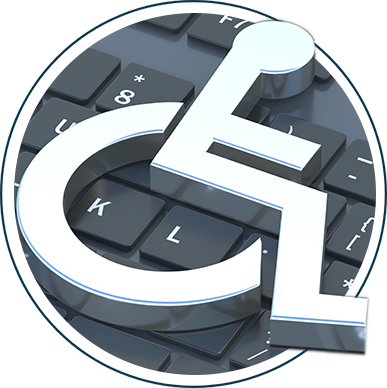
Enable keyboard navigation
Not all users can rely on a mouse. People with motor, physical, or visual impairments often depend on keyboard navigation. A fully accessible site must work with just a keyboard, allowing users to move through pages, select links, and interact with all elements.
Interactive features like buttons and menus should be focusable, with navigation flowing logically (left to right, top to bottom). This ensures users always know where they are on the page. Regularly test your site with only a keyboard and screen reader, for example, pressing “Enter” or “Spacebar” to confirm buttons work.
How to resolve:
There are several methods to improve keyboard accessibility. For example:
- To make an element accessible via the Tab key, you can add a “tabindex=0” tag.
- You can make it easy for users to skip to the relevant sections by adding a “skip to main content” link to the page.
- Make sure that any interactive elements are descriptively labelled, so users understand what will happen when they select it. For example, any links (or linked elements) should include descriptive anchor text.
Add captions, transcripts, and audio descriptions to your media
One of the core principles of the WCAG is that content should be “Perceivable”. Users should be able to “see” or “hear” your content, no matter what disabilities they have.
That can be challenging with video content. Visually-impaired people will not be able to see it, and those with auditory impairments won’t hear it. Fortunately, there are solutions. Captions and transcripts provide text versions of the auditory content, whilst audio descriptions make the visual content of your videos accessible to visually-impaired people.

How to resolve:
Here are a few different methods worth considering:
- Captions: Add open or closed captions directly to the video. Ensure they’re accurate, clear, and in sync with audio. Use professional services or carefully review auto-captions.
- Transcripts: Provide a full transcript on a separate web page or as a downloadable file.
- Audio descriptions: Describe visual details (e.g., scene changes) during natural pauses in dialogue. Ensure narration is recorded to a professional standard.

Correct semantic structure
If you opened a book and found all the chapters and pages out of order, you’d probably put it down again. Websites are no different. Poor webpage structure, with inaccurate or absent headings, makes navigation very difficult. That’s especially true for those who use assistive technology, like screen readers, but it applies to all web users.
It’s also a common issue. 39% of web pages have an incorrect heading hierarchy, whilst a shocking 9.8% have no headings whatsoever! Naturally, this can have a deterrent effect on your ADA compliance.
How to resolve:
Ensure your Drupal website uses headings correctly. Webpages should follow a clear heading hierarchy, starting with a H1 for the webpage title. A webpage should only have one H1, so the subsequent sections will require a H2, and H3s for subheadings.
Always use the correct semantic HTML for headings (<h1-h6>). Don’t be tempted to format it yourself with bold or enlarged text, as this will make it inaccessible for screen readers.
Get started with a free ADA compliance audit of your website today
The issues above could potentially be affecting your Drupal website’s ADA compliance. But how can you be sure? Trying to find every issue without guidance can be time-consuming and overwhelming.
Fortunately, automated audit tools can simplify the process. For example, Recite Me’s web accessibility checker runs an automated scan to detect ADA compliance issues. Its 396 scans are applicable to WCAG 2.2 Level AA, and it covers PDF and image content, as well as web pages.
Once the audit’s complete, you’ll get a detailed report with a list of errors to remediate. Follow up with a manual, human-led audit to double check nothing’s been missed. Using a free downloadable web accessibility checklist makes the process simple.

Remediating issues
Now you have your ADA compliance report. So, what’s next? You’ll need to review the list of violations and decide which to prioritize. Aim to resolve high-priority violations first. These will typically be things like inaccessible web forms and menus that infringe on user functionality.
After this, take care of ADA compliance issues on frequently visited pages, including product pages. You should also prioritize any fixes that can be resolved quickly, such as adding missing alt-text.
Schedule future audits for ongoing compliance
ADA compliance is subject to change, so you should aim to schedule future audits. For example, in April 2024, updates were made to Title II, requiring federal agencies to meet specific web accessibility standards in line with WCAG 2.1 Level AA.
Aside from compliance updates, regular audits ensure that any new content on your website meets the requirements.

Why is it important to comply with ADA guidelines
ADA compliance might not seem like a major priority for your business. Unfortunately, that can be a damaging, and costly, mistake. Here’s why it’s so important to make your website ADA compliant:
- Legal risks: If your Drupal website doesn’t meet accessibility standards, your business could face hefty ADA compliance lawsuits and fines.
- Brand damage: Refusing to make your website accessible to disabled people can negatively impact on your brand, leading to bad press and boycotts.
- Lost customers: Estimates suggest that disabled people and their loved ones have an annual spending power of $13 trillion. Neglecting these customers can severely impact your income.
- Equality: Making your website ADA compliant ensures that disabled people have equal access to your online content. That creates a fairer internet for all.
Get a free automated ADA compliance audit of your website. This audit will highlight compliance violations and provide the recommendations needed to meet ADA compliance standards.
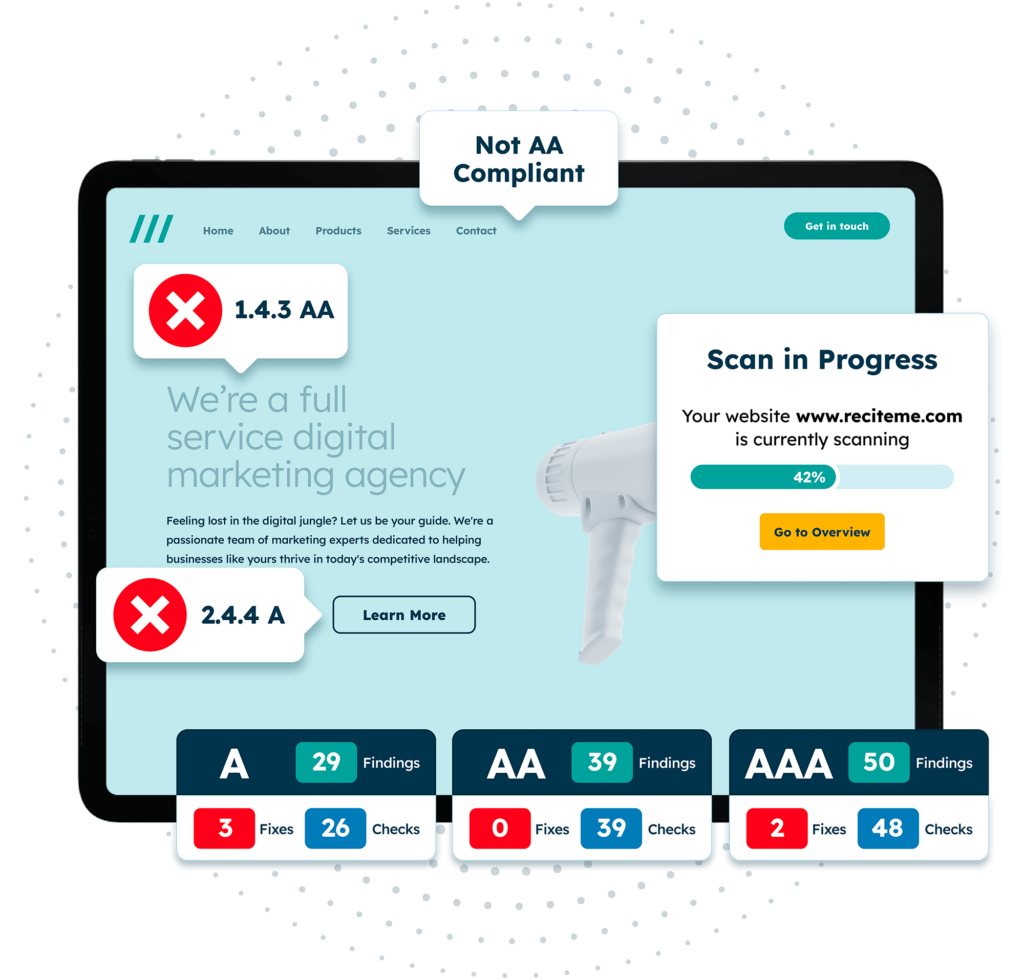
Support your team with additional ADA accessibility training
Another way to ensure continued compliance for your Drupal website is ADA accessibility training. This can tackle your business’ accessibility issues at its core.

When your web developers, marketing managers, and content writers learn about accessibility principles, they can identify future violations before they’re made.
Recite Me offers a free ADA accessibility course to meet digital compliance requirements. It covers everything from the basics of accessibility to putting the ADA requirements into practice online. Your staff can work through the three modules at their own pace. Plus, it takes just 25 minutes to complete.
Conclusion: Get your Drupal website ADA compliant today
ADA compliance doesn’t have to be daunting. From Drupal’s accessibility features to automated web audits, you’ll have a compliant website in no time. That’s good for your web visitors and your business.
Not sure what your next step should be? Start with a free web accessibility audit to put your website to the test. Or if you need more intensive support, our web accessibility experts can provide a personalized approach.
ADA compliant Drupal websites FAQs
Looking for a recap or quick summary? Here are a few of our most frequently asked questions to help you get to grips with the essentials:
Is Drupal WCAG compliant?
Drupal includes several accessibility features, and generally strives for compliance with WCAG 2.1 Level AA at a minimum. However, the compliance of your Drupal site will depend on its theme, modules, style, structure, functionality, etc. Use automated tools like a web accessibility checker to audit your website for violations.
How do I make my Drupal website WCAG compliant?
To make your Drupal website WCAG compliant, you should resolve accessibility issues. As a first step, conduct a website accessibility audit. Potential violations include:
- Missing alt-text for images
- No keyboard-only navigation
- Incorrect heading hierarchy
- No captions or transcripts for media content
- Poor color contrast
- Flashing images and/or content
Do all Drupal websites need to be WCAG compliant?
Generally speaking, yes. For federal agencies, it’s legally required under Title II of the ADA. Although it’s not necessarily a legal requirement for other business types, it’s still highly recommended. That’s because neglecting web accessibility can lead to ADA lawsuits, lost reputation, and reduced revenue.
Need more help becoming ADA compliant?
The following resources are packed full of actionable tips and expert advice for making your digital content compliant with the Americans with Disabilities Act:
Free ADA Accessibility Training
Take the first step to ADA compliance by completing our training course.
Free ADA Accessibility Guide
Ensure your organization is meeting the requirements for ADA compliance.


